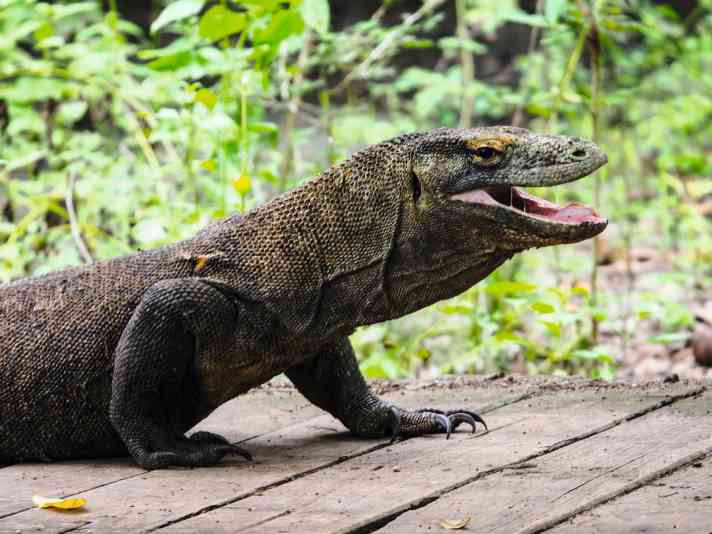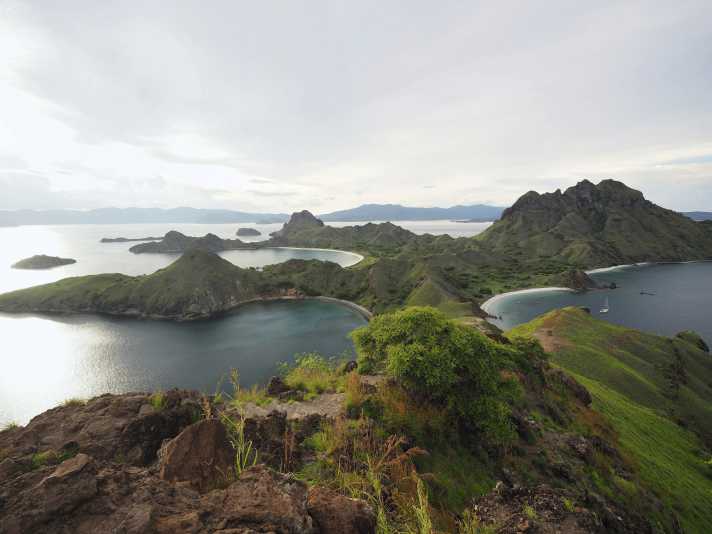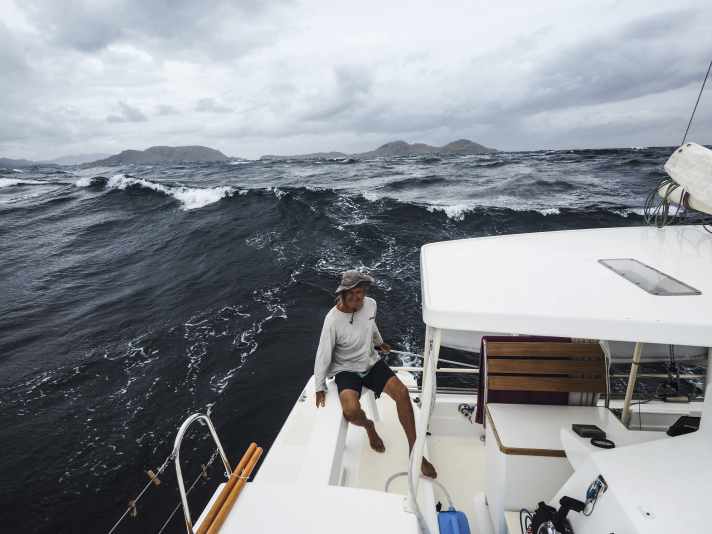





My brother Jörg says that he only became a boat builder because our father didn't want to buy him a dinghy cruiser when we were young. That was a long time ago. A whole professional life. Jörg has lived in Indonesia for almost 30 years. He was the director of a furniture company there. Just in time for his retirement, he built himself a catamaran on Java. A Woods design, type Gypsy 28, whose construction plans are sold as a "budget offshore cruiser".
The only problem with the budget in Indonesia, says Jörg. Apart from wood and cheap labour, pretty much everything has to be imported with a steep one hundred percent luxury tax. One reason why he even built the carbon fibre mast himself. The result is something to behold and to sail. The boat is light, stable and fast.
Komodo National Park is a Unseco World Heritage Site...
Brother Jörg and his wife Thawin are now sailing through the Indonesian islands for the third season. The destinations they head for always depend on the trade winds. It changes direction at the end of the rainy season. At the beginning of the season, they therefore head eastwards from Java via Bali, Lombok and Sumbawa with north-westerly winds. Flores, Rinca and Komodo are located there.
The Lesser Sunda Islands lie to the east of Bali. They include Komodo, Rinca and Padar. They are part of the national park
Together with a few other larger and countless smaller islets, they form the most beautiful archipelago in Indonesia. Not least because of the monitor lizards that live here, the whole of Komodo is a national park and has been recognised as a UNESCO World Heritage Site since 1991. Reason enough to sail along with your brother. The starting point for a trip through the strangely barren, almost steppe-like islands is Labuan Bajo on Flores. This is a Muslim fishing village on an otherwise Christian island.

...and the boatbuilding trade along with it!
Although "Marina Labuan Bajo" is written in large letters on land, you will look in vain for moorings. Presumably because all the money went into an oversized-looking promenade and a number of grandstands. After some puzzling, they turn out to be an elevated refuge in the event of a tsunami.
My brother's boat, the "Apolonia", is moored alongside one of the countless excursion boats called pinisis. This is the traditional type of boat in Indonesia. The craft required to build a pinisi has also been recognised by Unesco as worthy of preservation. It is on the list of the intangible cultural heritage of humanity.
All the mooring buoys in the bay are tightly packed. Anchormen jostle between them. When the current changes, the ships come dangerously close to each other. It's hard to imagine the hustle and bustle in the bay when countless more tourist ships return from the diving grounds at Raja Ampats from May onwards. Even now, in mid-March, there is a lot of hustle and bustle and the rattling of numerous generators and engines fills the air.
In a light breeze, we make good time at first, passing a few very poor-looking fishing villages on the way. Our first landfall in the Komodo National Park is the island of Rinca. We moor the boat at a jetty.
Komodo dragon: Hungry dragon with deadly bites
If you want to see the local dragons and water buffalo and visit a small museum, you have to pay an entrance fee. Each day in the park costs per boat and person. Snorkelling and the obligatory guide cost extra. In the end, you end up holding a confusing bundle of tickets with lots of zeros on them. We end up paying a total of 650,000 rupiah, which is around 40 euros. My Indonesia travel guide says that you should always compare the amount you pay with the information on the tickets - which I unfortunately only read afterwards.
You don't have to go far to see your first Komodo dragon. The animal dozes calmly under the wooden walkway that leads around the grounds. The guide opens a gate and then, armed with a wooden stick and a slightly queasy feeling in his stomach, we head into the grounds. Because: "The dragons' sluggishness is deceptive," says the guide. "As soon as they get hungry, they become fast." They could easily catch up with a panicked fleeing human.
The Komodo dragon: three metres long, weighing over 70 kilograms, speeds of up to 20 kilometres per hour - and its bite is almost always fatal!
When monitor lizards bite, it is usually fatal for the victim. Their saliva contains a poison and 57 types of bacteria that cause a kind of blood poisoning. Komodo dragons can even take down huge water buffaloes. Occasionally, humans also fall victim to them.

I have to admit, I have rarely been so happy to return on board after a trip ashore. We spend the night at a safe distance from land on a buoy deployed by the park authorities.
As soon as we wake up the next day, a busy fisherman rows up in a dugout canoe in the first sunlight. He offers us his catch of the day, a grouper. He doesn't have many customers here. We are the only crew on a cruising boat. All the other tourists are travelling on one of the diving or tourist boats.
Komodo offers stunning views
The next stage destination is Pulau Padar. The second highlight of the national park awaits us there - literally: a viewpoint that has it all. We reach the island in the afternoon. We pass a fleet of squid fishermen waiting for the sun to set so that they can lure in their prey at night with artificial light. And all this in the middle of the national park! Apparently, the protection of marine fauna is just as important here as the change for the entrance tickets.
On Padar, we are the last visitors of the day - and therefore the only ones to make the strenuous ascent for a spectacular view. We are accompanied by various rangers who make sure we don't collapse on the way due to the heat. For good reason, most tourists make the ascent before sunrise. But even that is not without danger: the first rangers are already out and about from five o'clock in the morning to scare snakes away from the warm rocks.
Once at the top, the water bottle is almost empty. No matter, the rest is amazement. And taking photos. The surrounding islands are comparatively bare for their tropical location. As a European, you feel reminded of the Hebrides or the Lofoten Islands. Thankful that the sky was overcast a moment ago, you would wish for better light once you reach the top. But even so, the view over the hills, bays and beaches is stunning.

Fantastic beach in the bay of Pantai Merah
Back on board, we later enjoy the cooler evening breeze - and smile at the poorly adjusted lighthouse, whose cone of light seems to scan the island rather than send its beam across the water. Unfortunately, the initial silence is severely disturbed when four Pinisis suddenly drop their anchors around us. Soon afterwards, the generators for the air conditioning systems on board the ships rattle mercilessly and noisily.
As soon as the anchor drops somewhere, it's off on a discovery tour. There's plenty to see - both above and below the water!
The next morning, after a half-awake night, we walk up the anchor and the path to the viewpoint, which we had taken on our own the day before, is as crowded as Mount Everest. Everything done right. The island of Komodo now lies ahead. More precisely: the Pantai Merah bay there. Lined by a beautiful beach and protected by an offshore coral reef. Unfortunately, there are no mooring buoys. It is difficult to find a suitable anchorage without damaging the coral. But as soon as we have found a bright patch of turquoise and the anchor has dug itself into the sand, the underwater amazement continues. Even snorkelling, we get to see lots of colourful fish, rays, sea turtles and soft corals. It all looks pleasingly intact, probably due to the lively exchange of water that the currents between the islands bring with them.
Rollercoaster ride off Komodo in wild cross seas
We learn the downside of the tides here off Komodo on one of the next days. In supposedly moderate conditions, we leave a bay with a stern wind. After just one mile, I'm amazed at the surf on the horizon. Shortly afterwards, we find ourselves in a nasty cross sea. The stern wave is literally overrun at right angles by an old swell from the Indian Ocean.
I have rarely experienced anything like it. Immediately behind the ship, the waves marry and build up. Fortunately, the "Apolonia" is so light and agile that the breakers don't enter the cockpit from aft. Instead, they lift the ship, which then shoots into the next wave trough at speed. We barely make any headway on this rollercoaster ride. On average, we are travelling at two to three knots over the ground.
Prohibition to leave in unusual conditions
Brother Jörg is visibly tense, Thawin disappears below deck and treats himself to a glass of rum to calm down. We are all happy when we finally go to the mooring in Labuan Bajo. There we learn that all ships have been banned from leaving the harbour for the next few days. No wonder, when you look at the slim and tall Pinisis. They would hardly get through such a witch's kitchen unscathed.

My brother says he has never experienced weather like this here before. I can't help but think of climate change and its consequences. Before Jörg sails on to the islands at the other end of Flores, he wants to wait for better conditions. Despite his well-sailing catamaran, the fun stops at the cross at the latest. Understandable. In any case, I would love to be back for the sequel.

